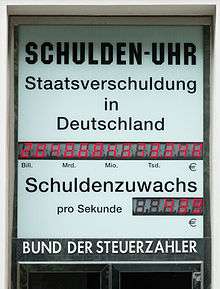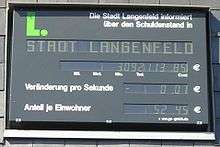Debt clock
A debt clock is a public counter, which displays the government debt (also known as public debt or national debt) of a public corporation, usually of a state, and which visualizes the progression through an update every second. Because of the mirror-image correlation between liabilities and accounts receivable meanwhile there are assets clocks or property clocks also, which visualize the private and state assets. Clocks to display the national interest charge are called interest clocks.


Purpose
The debt clock strikingly shows the dynamics of the state's debt growth. In this connection private debts and the growth of the monetary assets of the creditors are disregarded. The debt clock, besides showing the actual new indebtedness of the state through investment credits from government bonds, as well shows the effect out of interest and compound interest ("interest on interest") and the swelling of state indebtedness coming from the interest payable.
Examples
Many countries and cities have public debt clocks installed.
- The first debt clock, the United States' National Debt Clock, was installed in 1989 at the intersection of 42nd Street and Sixth Avenue on the initiative of real estate developer Seymour Durst. It was relocated in 2004 to 1133 Sixth Avenue,[1][2] and then again relocated in 2017 to the east wall of the arcade, which connects West 42nd and 43rd streets.[3]
- Germany, German Taxpayers Federation debt clocks:
- Berlin: A German debt clock is located at the entrance of the Federation headquarters since 16 June 2004. Besides the progression of German national debt, the increase per second is displayed too.[4] The Taxpayers Federation estimates these values by adding an estimated probable borrowing of the current year to the state indebtedness of the previous year.[5]
- Wiesbaden: Also at the former headquarters of the German Taxpayers Federation in Wiesbaden, a debt clock has been running since 12 June 1995, which displays the total public debt, the per capita debt and the debt increase per second.
- Germany, Landtag of Lower Saxony: This debt clock is located in the group hall of the CDU (German party) in the Landtag of Lower Saxony.
- Germany, Munich: a debt clock has been running since 29 February 2008.[6]
- Germany, Bonn, Haus der Geschichte: this one displays the total debt, debt per second and per capita debt.
- Germany, Düsseldorf, City Hall: Düsseldorf is a city which has been debt-free since 12 September 2007 after the sale of a RWE block of shares. There, the elapsed time is displayed instead of the debt.[7]
- Germany, Langenfeld, Rhineland: after Langenfeld had become debt-free in 2008, the debt clock got dismantled.[8]
Critics
The missing confrontation of the growing assets and the increasing debts is criticised i.a. on the part of the unions. In this context an assets clock or property clock displaying the rising assets is encouraged.[9]
Senior economist of the United Nations Conference on Trade and Development (UNCTAD), Heiner Flassbeck, in February 2007 criticised the bias and striking impact of the debt clock. He suggested to put a clock aside with a display of the private assets/property and its growth to enable the judgement of the debts against the background of present property values and assets.[10] Meanwhile property- or richness clocks in several variants were published.[11]
References
- New York Post Archived 2008-10-06 at the Wayback Machine
- Spiegel Online
- New York Post, 5 June 2017
- "German Taxpayers Federation (stand: 19 April 2011)". Archived from the original on 2 March 2009. Retrieved 11 March 2015.
- Spiegel: "They lost their credibility" (German), 28 October 2010
- Taxpayers Federation Bavaria
- Manager-Magazin: Düsseldorf is debt-free (German), 2007
- WDR
- WDR
- German article from the Frankfurter Rundschau, 28 February 2007 (PDF; 45 kB)
- Richness clock Hamburg at radiohamburg.de retrieved 2 May 2011
External links
- Debt clocks of the 28 European Union member states and Interest clocks in Germany and Austria at haushaltssteuerung.de
- European Debt Clock
- Steuerzahler.de, Web site of the German Taxpayers Federation with a running debt clock at the page header
- USdebtclock.org, Detailed debt clock of the United States of America
- Debt clock with assets clock
- Reichtumsuhr.de, Web site with a comparison of private assets/richness and public debt in Germany
- National debt clock of Canada
- National debt clock of France
- National debt clock of Austria
- National debt clock of the United Kingdom
- National dept and wealth clocks of Finland
- Debt Clock of Pakistan